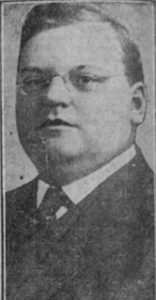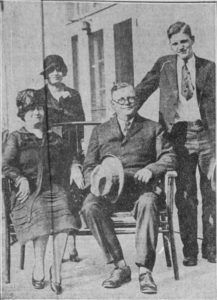
Sometimes the pressures of life can make one want to run away and start over. Oftentimes people do not act on these feelings, but in 1923 one person did: Lewis E. Larson. A member of the Chicago Board of Education, Larson once sent Jane Addams a report on kindergarten membership in 1906. Nearly two decades later, Larson went missing for over three years, and was next found in Texas living an entirely different life.
Larson lived a simple life in Chicago, where he served as secretary for the Chicago Board of Education and business manager for Chicago public schools. He also worked as a real estate agent, treasurer of the Portage Rubber company, and general manager of Willoughby & Co. Larson married Mary Wildman in 1897, and they had two children together. When Larson sent Addams a report on kindergarten monthly membership throughout 1905 and 1906, nothing seemed awry. But by 1923, it was clear that Larson was not satisfied with his current life.
On March 7, 1923, Larson mysteriously disappeared without a trace. His disappearance was reported in The News-Palladium, which also spoke of the disappearance of Reverend John Vraniak, suggesting the two cases were connected. Larson reportedly withdrew $200 from the bank before disappearing, and though his work and personal lives were apparently “in excellent shape,” according to the Chicago Tribune, he had been complaining about being overworked. Some thought Larson had amnesia, some thought he was dead, and others believed he hadn’t left Chicago at all; in April, his wife Mary visited a Miss Frances Heiple, who claimed to have seen Larson walking through the city. This story generated no new leads, however, and the search for Larson continued.
In September 1926, when hope seemed lost, Larson suddenly resurfaced – in Dallas, Texas. James D. Pasho, who used to work with Larson at the Portage Rubber company, saw the missing board member while walking past the Adolphus Hotel in Dallas. Pasho and Larson then reminisced about old times. Pasho described Larson as looking “better than I had ever seen him look…He appeared very prosperous.”

In the three years Larson had been gone, he had a variety of jobs and lived in a plethora of places. He later explained to the Chicago Tribune that he left his former life because of a “mental lapse” caused by “nerves and worry.” He stated, “Something within me drove me on. I first went to St. Louis from Chicago. I was dizzy and my brain was reeling…But I couldn’t rest. I took a train to Kansas City.” In a separate Chicago Tribune article he said he “broke down under the strain.” Larson had also been to Shreveport, Louisiana, and Little Rock, Arkansas, before ultimately ending up in Texas. He found employment as a salesman for the General Motors Truck Company, as a truck driver, and as a superintendent of construction for an asphalt company.
Pasho had only heard of Larson’s disappearance in passing, and he wrote to their former boss and relative of Larson’s, W. W. Wildman, recounting the experience. The letter traveled to the Larson family, and soon arrangements were made for Larson to reunite with his family. But the reunification had a rough start. Larson’s son, Leonard, made arrangements to travel to his father, but because of a communication error, Leonard traveled to Baton Rouge while Larson remained in Texas.
But soon father and son were reunited, and Mary and Lucille, Larson’s daughter, traveled to meet him as well. Larson stated he was “tired of it all,” and would “be happy to get back to my family.” However, he did not want to return to Chicago quickly. Leonard and Lucille returned to Chicago shortly after the reunification, but Mary stayed with Larson in Texas for six weeks as he tied up loose ends in his new business ventures.
Eventually, Larson did return to his family and resume his old life in Chicago, though he also maintained business ties in Texas. He also began working for H. C. Speer & Son, an investment and bond company. Larson retired in 1949, and he died in February 1953. His obituary mentioned nothing of the period of his life in which he was missing, and it became just another story to be found in the archives of newspapers.
Sara Catherine is writing a series of blog posts about interesting characters that she comes across while working as a co-operative education student for the Project this semester. Her work involves identifying and describing the over 5,000 individuals mentioned in Addams’ correspondence.
Sources:
“Larson Still in City, Conviction of Mrs. Larson,” Chicago Tribune, April 3, 1923, p. 13.
Lewis E. Larson, 1910 United States Federal Census.
Lewis E. Larson, 1900 United States Federal Census.
Lewis E. Larson, Cook County, Illinois, Marriages Index, 1871-1920.
“Lewis Larson at Home Again After 3 Years,” Chicago Tribune, November 25, 1926, p. 1.
“Lewis E. Larson Found; Lost 3 Years,” Chicago Tribune, October 1, 1926, p. 1.
“Lewis Larson’s Son Home After Finding Father,” Chicago Tribune, October 12, 1926, p. 3.
“Lewis E. Larson Tells of His Wanderings,” Chicago Daily Tribune, Oct. 7, 1926, p. 1.
“Obituaries,” Chicago Tribune, February 12, 1953, p. 47.
“These Two In Port of Missing Men – But Where?” The News-Palladium, October 4, 1923, p. 1.

